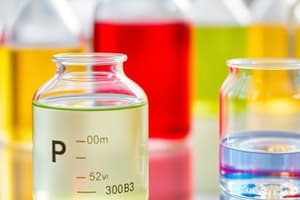Podcast
Questions and Answers
Which of the following compounds would be expected to exhibit metallic bonding?
Which of the following compounds would be expected to exhibit metallic bonding?
- Carbon dioxide (CO₂)
- Magnesium oxide (MgO)
- Sodium chloride (NaCl)
- Copper (Cu) (correct)
What is the primary reason why acids are corrosive?
What is the primary reason why acids are corrosive?
- They are typically colorless and odorless, making them difficult to detect.
- They have a low pH, making them highly reactive.
- They release hydrogen ions (H+) in solution, which react with many materials. (correct)
- They are strong electrolytes, meaning they readily ionize in solution.
Which of the following is NOT a characteristic of a typical metal?
Which of the following is NOT a characteristic of a typical metal?
- High electrical conductivity
- High melting point
- Brittle and easily broken (correct)
- Malleable and ductile
Which of the following is an example of an ionic compound?
Which of the following is an example of an ionic compound?
What is the main reason why a solution of sodium hydroxide (NaOH) is considered alkaline?
What is the main reason why a solution of sodium hydroxide (NaOH) is considered alkaline?
In the process of electrolysis, what is the role of the electrolyte?
In the process of electrolysis, what is the role of the electrolyte?
What type of bond is formed when two non-metal atoms share electrons?
What type of bond is formed when two non-metal atoms share electrons?
Which of the following indicators is most likely to be used to determine the pH of a solution with a pH of 10?
Which of the following indicators is most likely to be used to determine the pH of a solution with a pH of 10?
Which of the following metals would be most likely to react with a dilute acid to produce hydrogen gas?
Which of the following metals would be most likely to react with a dilute acid to produce hydrogen gas?
What type of bonding is typically found in metals?
What type of bonding is typically found in metals?
During electrolysis, which electrode attracts positively charged ions (cations)?
During electrolysis, which electrode attracts positively charged ions (cations)?
What happens to the anions during electrolysis at the anode?
What happens to the anions during electrolysis at the anode?
Which statement best describes the relationship between the reactivity of a metal and its tendency to form positive ions?
Which statement best describes the relationship between the reactivity of a metal and its tendency to form positive ions?
Flashcards
Acids
Acids
Substances that release hydrogen ions (H+) in water.
Alkalis
Alkalis
Substances that release hydroxide ions (OH-) in water.
pH Scale
pH Scale
Measures acidity (0-7) or alkalinity (7-14).
Strong vs Weak Acids
Strong vs Weak Acids
Signup and view all the flashcards
Neutralization Reaction
Neutralization Reaction
Signup and view all the flashcards
Common Acids
Common Acids
Signup and view all the flashcards
Ionic Bonding
Ionic Bonding
Signup and view all the flashcards
Covalent Bonding
Covalent Bonding
Signup and view all the flashcards
Physical properties of metals
Physical properties of metals
Signup and view all the flashcards
Chemical properties of metals
Chemical properties of metals
Signup and view all the flashcards
Electrolysis
Electrolysis
Signup and view all the flashcards
Anode and Cathode
Anode and Cathode
Signup and view all the flashcards
Reactivity series of metals
Reactivity series of metals
Signup and view all the flashcards
Study Notes
Acids and Alkalis
- Acids are substances that release hydrogen ions (H+) when dissolved in water.
- Alkalis are substances that release hydroxide ions (OH-) when dissolved in water.
- The pH scale measures the acidity or alkalinity of a substance.
- A pH of 7 is neutral.
- A pH below 7 is acidic.
- A pH above 7 is alkaline.
- Strong acids and alkalis fully ionise in solution; weak acids and alkalis only partially ionise.
- Acids react with bases to form salts and water (neutralisation reaction).
- Indicators are substances that change colour depending on the pH of a solution. Common indicators include litmus, phenolphthalein, and universal indicator.
- Common examples of acids include hydrochloric acid (HCl), sulfuric acid (H₂SO₄), and nitric acid (HNO₃).
- Common examples of alkalis include sodium hydroxide (NaOH) and potassium hydroxide (KOH).
- Acid rain is caused by acidic pollutants dissolved in rainwater, primarily from burning fossil fuels.
- Acid rain can significantly harm the environment by damaging vegetation, altering water chemistry, and corroding buildings and infrastructure.
- Neutralization reactions are important for controlling pH in various applications like industrial processes and biological systems.
Bonding
- Chemical bonding involves the attractive forces that hold atoms together in molecules or compounds.
- There are several types of chemical bonding:
- Ionic bonding: Occurs between a metal and a non-metal. Metals lose electrons to form positive ions (cations), and non-metals gain electrons to form negative ions (anions). Electrostatic attraction between these oppositely charged ions holds the compound together. Examples include sodium chloride (NaCl) and magnesium oxide (MgO).
- Covalent bonding: Occurs between two non-metals. Atoms share pairs of electrons to achieve a stable electron configuration. Examples include water (H₂O), methane (CH₄), and carbon dioxide (CO₂).
- Metallic bonding: Occurs between metal atoms. Electrons are delocalized and move freely throughout the metal structure, allowing for good electrical and thermal conductivity. Positive metal ions are surrounded by a 'sea' of delocalized electrons.
Metals
- Metals are elements that typically have high electrical and thermal conductivity, are malleable (can be hammered into shape) and ductile (can be drawn into wires). They generally have a high melting point and a lustrous (shiny) appearance.
- Metals lose electrons to form positive ions (cations).
- Common physical properties of metals include:
- High melting points and boiling points
- Good conductors of heat and electricity
- Malleable and ductile
- Shiny (lustre)
- Common chemical properties of metals include:
- They form positive ions by losing electrons
- They react with acids to produce hydrogen gas and a salt
- Some metals react with oxygen to form metal oxides
- Reactivity series of metals shows the tendency of a metal to lose electrons and form positively charged ions
Electrolysis
- Electrolysis is a process that uses an electric current to drive a non-spontaneous chemical reaction.
- It is used to decompose ionic compounds into their elements.
- The process involves passing a direct current through an electrolyte (molten ionic compound or a solution of an ionic compound).
- The positive electrode is called the anode, and the negative electrode is called the cathode. At the anode, anions lose electrons to form neutral atoms. At the cathode, cations gain electrons to form neutral atoms.
- Electrolysis of molten ionic compounds produces the elements at the electrodes.
- Electrolysis of aqueous solutions produces elements at the electrodes, but also hydrogen or oxygen in some cases, depending on the relative reactivity of the ions.
- Factors affecting the electrolysis process may include the concentration of the electrolyte, the temperature, and the type of electrodes used.
- Electrolysis has various applications, such as electroplating (coating one metal with another), refining metals, and producing chemicals.
Studying That Suits You
Use AI to generate personalized quizzes and flashcards to suit your learning preferences.




